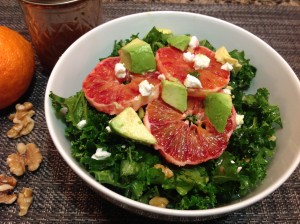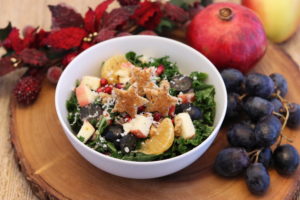 Have you noticed blood oranges showing up at your local stores?
Have you noticed blood oranges showing up at your local stores?
If so, do you savor these while they are available, or do you tend to walk past them, opting for the more recognizable navel, mandarin or clementine oranges?
Because of the conditions required to grow blood oranges, their peak ripeness is starting right now and will probably last through March or April. So, while regular oranges are available year-round, the blood orange season is relatively short, which is the perfect reason to eat with the seasons and enjoy them RIGHT NOW!
I still remember my first introduction to blood oranges.
A friend dropped off a bag of oranges and said, “Someone gave these to me and told me they are blood oranges. I have no idea what to do with them and, honestly, I am kind of afraid to try them.” We might have said the same thing before our REAL food journey, but that all changed once we started experiencing the rainbow of REAL foods!
What exactly are blood oranges?
 First of all, they are indeed oranges.
First of all, they are indeed oranges.
The reason they are called blood oranges is because they are high in a compound called anthocyanins, which gives them their deep dark red and orange colors. This is the same health-boosting compound that results in the vibrant colors in other foods like blueberries, blackberries, cranberries, eggplant, red onions, purple cabbage, beets, cherries and so many more! You might remember us talking about this in our coaching tip “Does Color Matter?”
Blood oranges tend to be slightly smaller than navel oranges and have fewer seeds. Some say they are a little more difficult to peel, but we haven’t experienced this.
Blood oranges grow best in climates where the days are warm and nights are cold. The best varieties come from Italy, Sicily and Spain, and in the U.S. there is some production in California and Texas. You might see some blood oranges from Florida, but be aware that the Florida blood oranges may disappoint because it typically doesn’t get cold enough to develop the anthocyanins and the resulting color, flavor and aroma. When buying them, look for oranges that are firm and heavy for their size, and then you can store them on the counter for a few days or in the fridge for a couple weeks.
The most common varieties of blood oranges include:
 Moro (or Morro): the flesh has a deep red color and the skin tends to be a little thicker than other varieties.
Moro (or Morro): the flesh has a deep red color and the skin tends to be a little thicker than other varieties.- Taracco: these tend to have a round shape and are on the sweeter side. Their skin often looks the same as a navel orange, so it is what’s on the inside that counts!
- Sanguinello: this variety originated in Spain and tends to have more of an oblong shape and may have a red tint on the skin.
What about the taste and nutrition?
Blood oranges have a more complex flavor and aroma compared to more common oranges…which is a very good thing! They have a more intense aroma and the flavor tends to be sweeter with a slight tartness at the end. This makes them perfect for both savory and sweet dishes. Some say they have a slight raspberry flavor and aroma.
Nutritionally, blood oranges provide all the benefits of regular oranges. Although, the nutrients in blood oranges are amped up even more because they provide the benefit of the anthocyanins, which provide antioxidant benefits such as reducing the risk of heart disease and cancer, improving eye health, reducing inflammation and many other benefits!
How do you enjoy blood oranges?
There are SO MANY ways! Of course, blood oranges are interchangeable with regular oranges in any recipe. Their more complex flavor will add great taste as well as a visual appeal, because let’s be honest…they look super cool! And, don’t forget to enjoy the zest!
 They would get rave reviews on your holiday table in the Pomegranate Christmas Tree Salad, Christmas Quinoa Salad or the Roasted Brussels Sprouts with Oranges & Peanut Vinaigrette.
They would get rave reviews on your holiday table in the Pomegranate Christmas Tree Salad, Christmas Quinoa Salad or the Roasted Brussels Sprouts with Oranges & Peanut Vinaigrette.- They are a beautiful addition to winter salads like the Kale Salad with Blood Oranges & Goat Cheese, the Winter Blues Fruit Salad or the Roasted Beets & Orange Salad. .
- They also taste fantastic combined with spicy and bitter greens…like in the Arugula Salad with Orange Sesame Vinaigrette or the Sweet Orange Roasted Fennel & Radish Salad.
- They are used in a lot of cocktails because of their vibrant color and flavor. For a non-alcoholic alternative, combine the juice with some seltzer water for a flavorful and refreshing drink!
Some other delicious and nutritious ideas include:
 Not Your Ordinary Grilled Cheese Sandwich
Not Your Ordinary Grilled Cheese Sandwich
Moroccan Salad with Cilantro Orange Dressing
Sautéed Squash with Oranges & Pistachios
Mediterranean Burgers with Sweet Orange Salsa
Citrus Salad with Maple Vinaigrette
 Orange Farro Salad with Spring Veggies (during the transition from winter to spring produce)
Orange Farro Salad with Spring Veggies (during the transition from winter to spring produce)
Here’s a challenge for you!
Next time you see blood oranges at the store, don’t walk on by! Pick up a couple, try one of these recipes, and then let us know what you think!
 LEARN MORE ABOUT THE NAPKIN!
LEARN MORE ABOUT THE NAPKIN!


We fist had these in Florida. They are delicious!
We completely agree – thank you!
The not your ordinary grilled cheese is my favorite with blood oranges, have done it with regular oranges just not the same, LOVE LOVE LOVE this sandwich on a cold snowy night!
It really does amp up the flavor, doesn’t it?! Thank you for the feedback, we are so glad you enjoyed this!